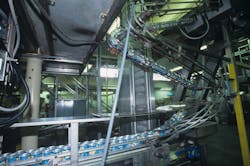Making Incremental Changes in Your Lighting System
Lights and motors are the biggest energy users in a typical industrial or commercial facility, so it makes sense to look at those loads when saving energy is the goal. In facilities where other types of loads are the main energy users, it may not be possible or practical to reduce the amount of energy those loads consume.
Those cases include, for example, hot process plants such as factories that make glass bottles or factories that extrude aluminum. You can’t save energy without a major redesign of your basic production processes. In those cases, you’re left with focusing on lights and motors to gain any significant energy savings.
One way that many facilities save energy on lighting is an upgrade that replaces fixtures, ballasts and lamps. This can be a major investment in terms of cost. It can also be a disruptive one, especially if the facility is operating around the clock.
The disruption in operations is usually more of a barrier than the cost, because the savings from the upgrade nearly always provide an sizable internal rate of return and thus the cost is easily justifiable. But if the installation job causes enough downtime to reduce revenue by $650,000, that project is not as easily justifiable. With this dynamic in place, such a project often will be scheduled to take place during a plant shutdown.
But a major lighting removal and replacement project isn’t your only option. Other things you can do:
- Install lighting controls. With occupancy sensors, daylight sensors and timers, a facility that operates on a single-shift basis can save more energy with the same, relatively inefficient lighting in place than if it upgraded the existing lighting system. It probably still makes sense to do the upgrade later, but installing the controls now provides immediate savings at a fairly low cost.
- Upgrade or move select luminaires. You may be able to eliminate task lighting simply by replacing the lens in an existing fixture or two. In many cases, cleaning the lens does the trick. Or you may find that an existing luminaire has an adjustable shade that, when set correctly, eliminates the need for task lighting.
- Relocate light barriers, Act I. Sometimes a supply locker or other tall object is placed near production equipment, and it casts a shadow right where you don’t want it. The operator’s solution may have been to use a floor lamp or other task lighting to add light to the area, but a “free energy” solution is to move the object that’s casting the shadow. This simple solution often is overlooked.
- Relocate light barriers, Act II. In some cases, it’s not a locker, but two pieces of production equipment that were put in place without considering the lighting. In one factory, two rows of hydraulic presses were set up with the operator areas facing each other; the presses put those areas in shadow. Simply rotating the presses 180° put each operator station into ambient light and eliminated the need to add any luminaires.
Combining any of these other fixes with a well thought-out lighting upgrade plan will produce the most savings. When addressing lighting as an energy savings opportunity, be sure to look beyond just changing out the hardware. Look at the lighting design, how the lighting is controlled, and how the spaces being lighted are used.
About the Author

Mark Lamendola
Mark is an expert in maintenance management, having racked up an impressive track record during his time working in the field. He also has extensive knowledge of, and practical expertise with, the National Electrical Code (NEC). Through his consulting business, he provides articles and training materials on electrical topics, specializing in making difficult subjects easy to understand and focusing on the practical aspects of electrical work.
Prior to starting his own business, Mark served as the Technical Editor on EC&M for six years, worked three years in nuclear maintenance, six years as a contract project engineer/project manager, three years as a systems engineer, and three years in plant maintenance management.
Mark earned an AAS degree from Rock Valley College, a BSEET from Columbia Pacific University, and an MBA from Lake Erie College. He’s also completed several related certifications over the years and even was formerly licensed as a Master Electrician. He is a Senior Member of the IEEE and past Chairman of the Kansas City Chapters of both the IEEE and the IEEE Computer Society. Mark also served as the program director for, a board member of, and webmaster of, the Midwest Chapter of the 7x24 Exchange. He has also held memberships with the following organizations: NETA, NFPA, International Association of Webmasters, and Institute of Certified Professional Managers.

